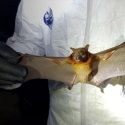They’re tinier than mosquitoes but their bite will have you in excruciating pain. While they’re feeding on you, they can transmit a variety of deadly diseases. And they don’t travel alone. In seconds you’ll be completely swarmed by these bloodsuckers. Sandflies are so small that they’re also known as ‘no-see-ums’ or ‘punkies’. They look like harmless little bugs, until the females start biting you while on the hunt for proteins in your blood to feed their eggs. If you’re allergic to them you can develop hives or have difficulty breathing but the most dangerous part comes months later. Sandflies are carriers of Carrion’s disease, filarial worms and leishmaniasis. This is as serious as malaria and can kill you if it goes untreated. Why shouldn’t you scratch the bites? What food can make you sandfly-proof? And how could a fan save your life?
Step 1. Get Your Vitamin B
These hazardous bugs live in sandy areas of tropical and subtropical regions of the world. You can avoid being bitten by wearing light-colored long-sleeved shirts, pants or anything that covers as much of your skin as possible. Use insect repellent on anything left exposed, like your face and hands. In New Zealand, where sandflies are extremely common, locals say that eating Vegemite, a popular sandwich spread, can keep them away. This might be due to Vegemite being packed with vitamin B, which seems to deter them.
Step 2. Turn on a Fan
Sandflies can be infected with leishmaniasis, a parasitic disease that they can pass on to you. Leishmaniasis is one of the most dangerous tropical diseases. It’s second only to malaria in parasitic causes of death and is responsible for deadly epidemics in South America, East Africa and Asia. If you live in these regions, avoid going outside between dusk and dawn. That’s when sandflies are most active. Inside, keep the fans turned up. They aren’t great fliers, and the extra breeze will help keep them off of you.
Step 3. Beware of Ulcers
Sandflies aren’t loners. If you spot one, you can be sure that hundreds of them are about to hit and chances are you won’t get away without being bitten a few times. Use an ice pack or wet cloth on any bites to help with the itching and swelling. If you develop blisters, you might be infected with leishmaniasis. There are three forms in which the disease can get you. Cutaneous leishmaniasis is the most common. It manifests with ulcers on your skin, and treatment isn’t always necessary. However, this can evolve into the mucocutaneous form. In this stage, the parasites spread to your nose, throat and mouth, destroying mucous membranes along the way. Symptoms, including nosebleeds and ulcers in the mouth or lips, can take up to five years to appear. As bad as this sounds, there’s a good reason why you absolutely need to follow this next step to avoid an even worse outcome.
Step 4. Seek Treatment
The more severe form is visceral leishmaniasis. This will damage your internal organs, bone marrow and your immune system. It’s almost a guaranteed death sentence if it isn’t treated. The symptoms start to show two to six months after the initial infection and can include weight loss, fever and an enlarged spleen.
Step 5. Don’t Scratch
Every year, there are about 1.2 million new cases of cutaneous leishmaniasis. If you get this form of the disease, you may not need immediate treatment but the ulcers will be itchy. If you scratch them, they’ll leave a scar. Even though the blister can heal on its own, don’t brush it off like you would with a mosquito bite. Take it seriously. Let your doctor know and follow their advice on how to prevent the progression of the disease before it’s too late.
Sources
- Whar Are Sandflies?. McMahon, M. (2022). All Things Nature.
- Leishmaniasis (2022). Healthline.
- Preventing and treating Sand Fly Bites (2022). Far North Training and Consultancy.
- New Zealand’s Darkest, Bloodiest Secret: The Sandfly. Bland, A. (2012). Smithsonian Magazine.
- About Leishmaniasis (2022). Centers for Disease Control and Prevention.

















